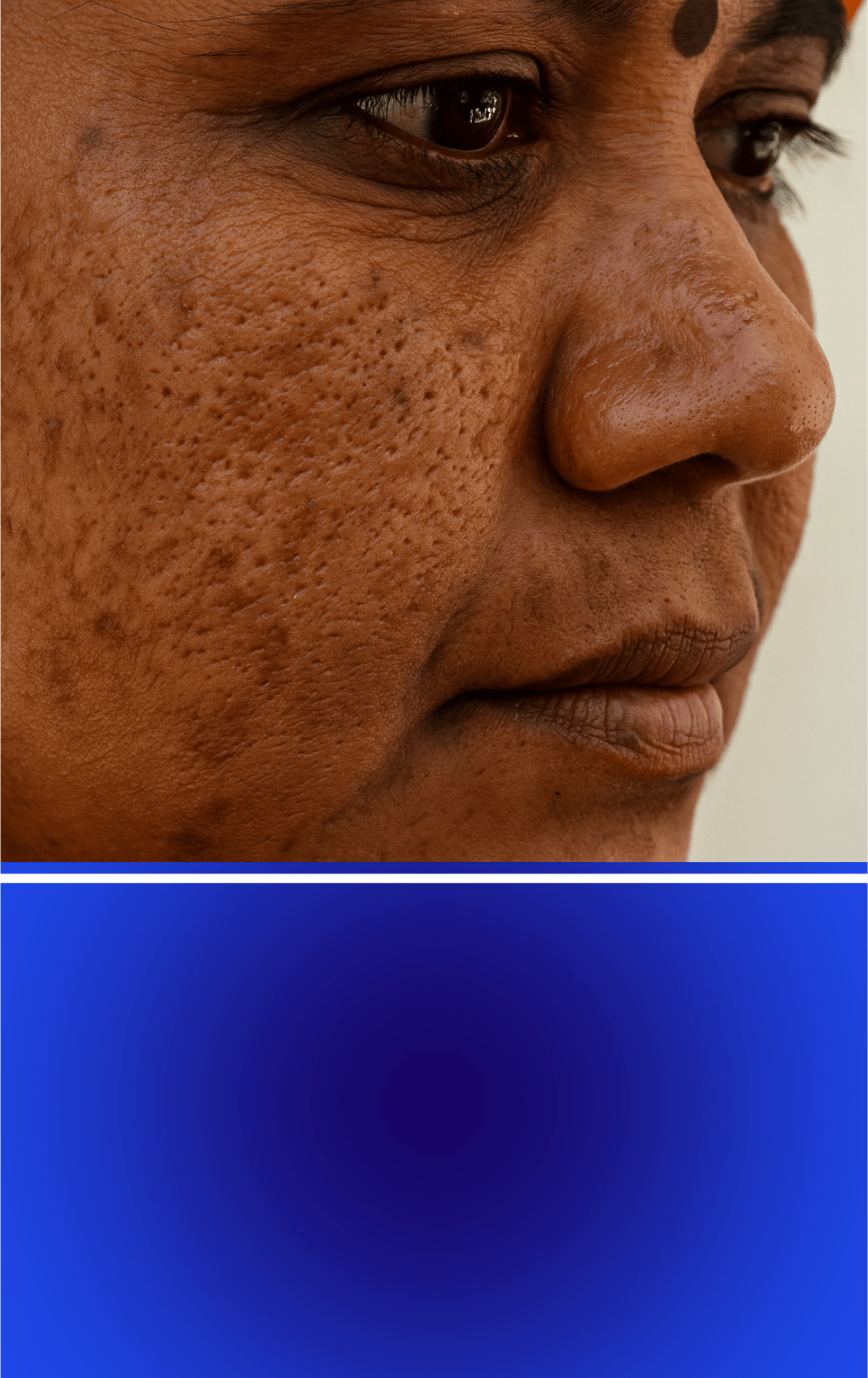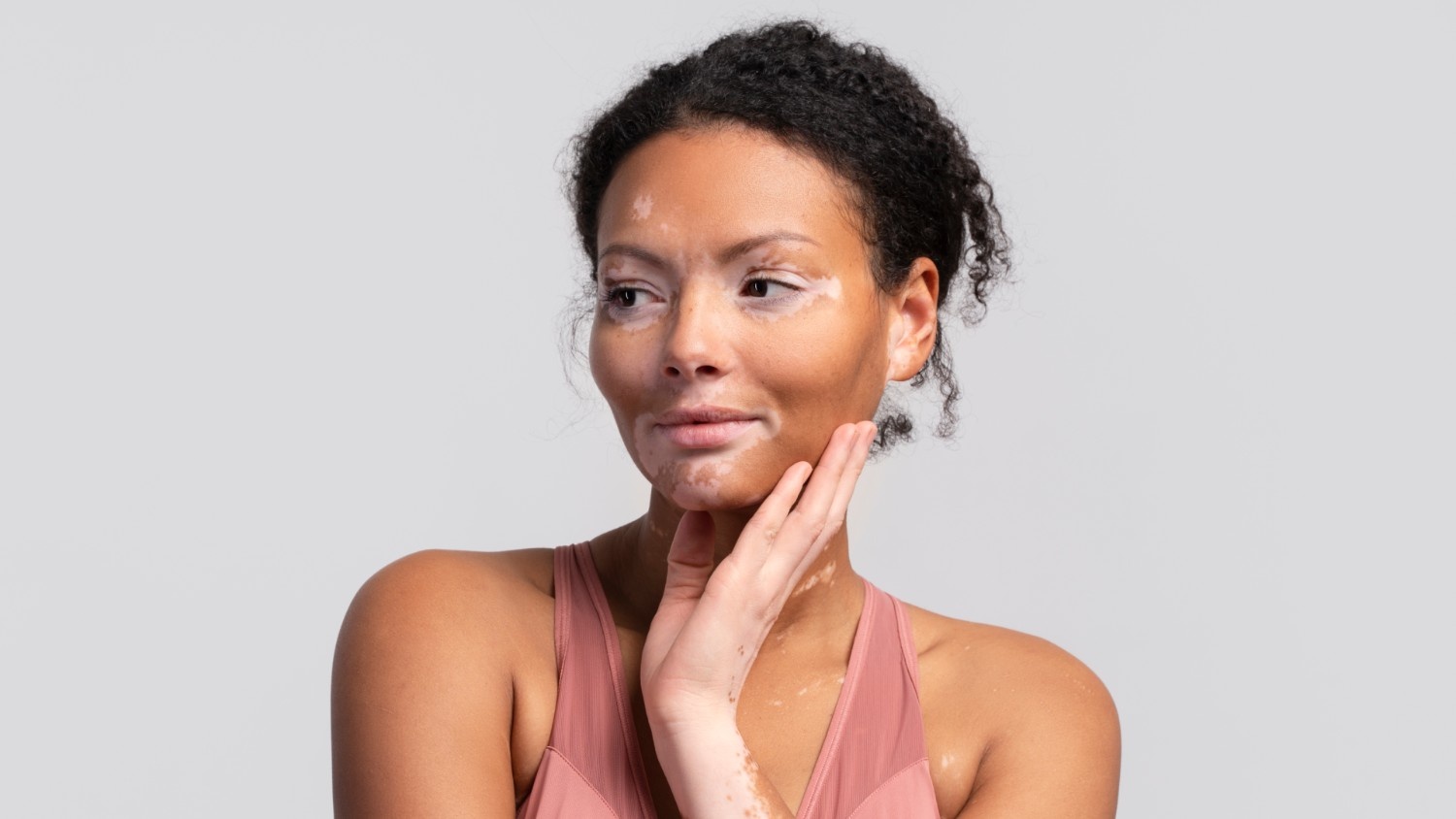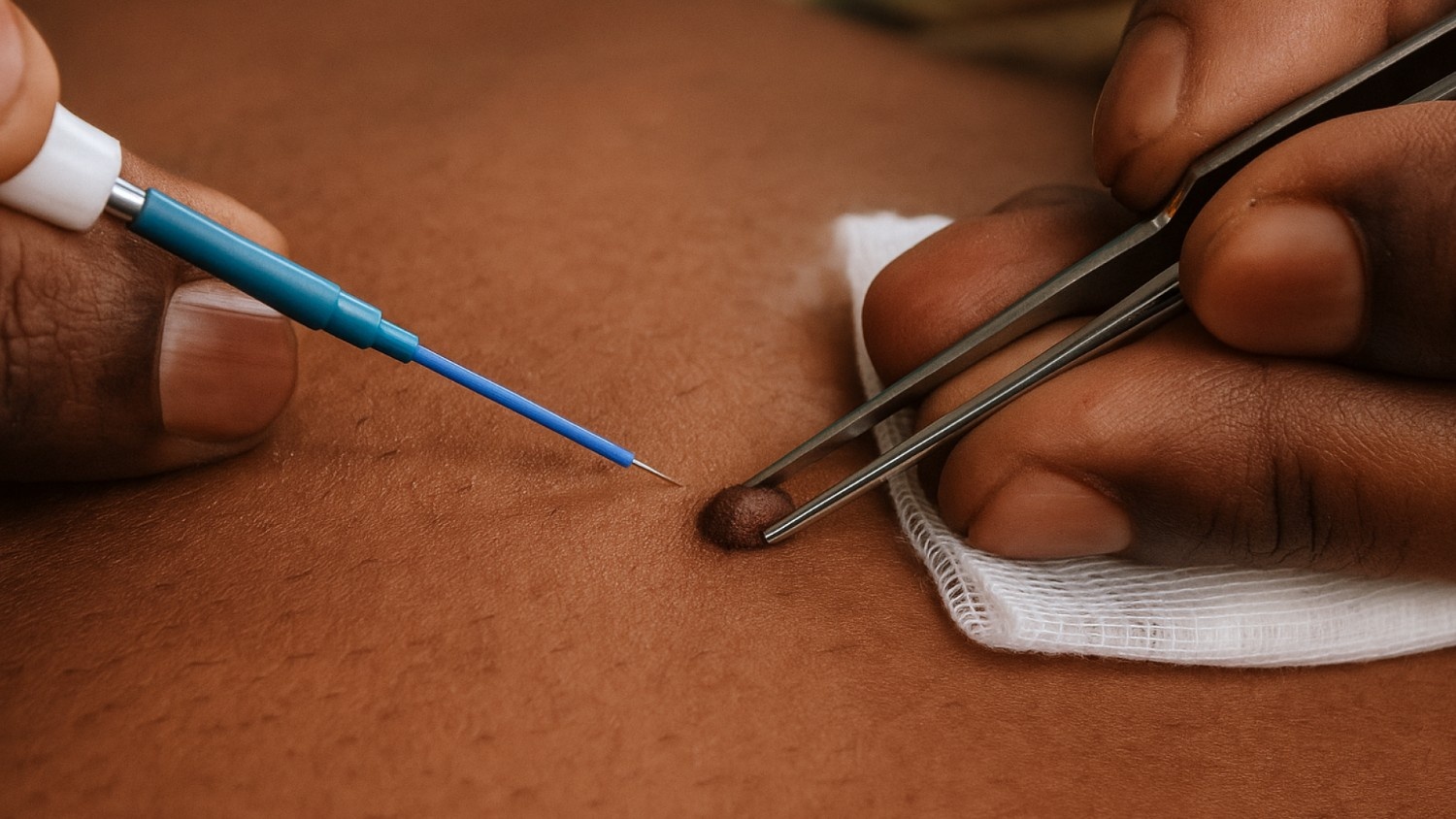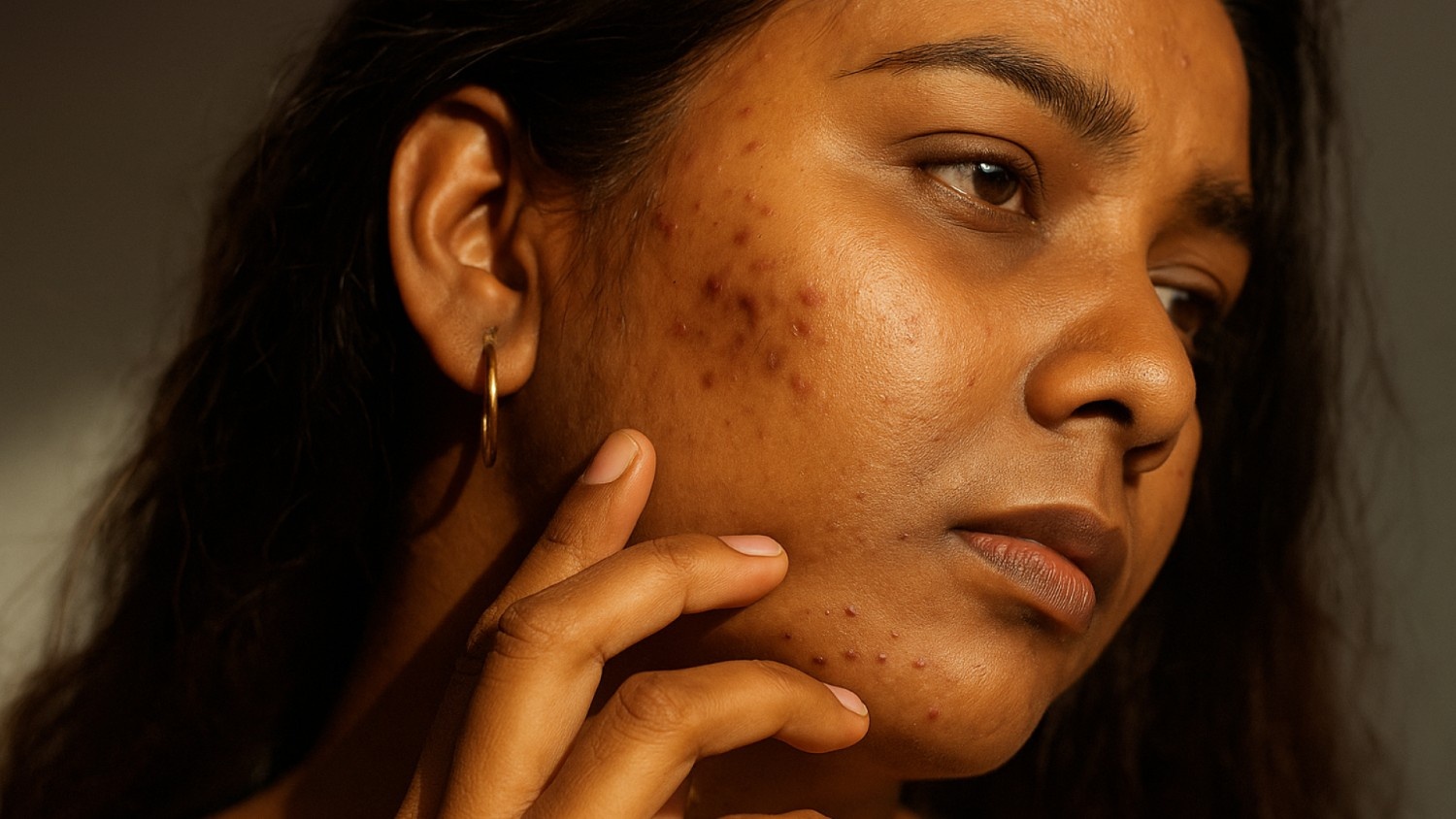Approximately 1.73 billion people worldwide face fungal infections at some point, often struggling with persistent itching, discomfort, and visible skin changes that can affect confidence and daily life.
Living with these symptoms can be frustrating and isolating, especially when quick fixes don’t work or infections keep coming back.
This is where fungal infection treatment plays a crucial role. Getting the right diagnosis and care not only eases your symptoms but also helps prevent infections from returning, giving you peace of mind and comfort.
In this guide, you’ll learn to identify common fungal infections, understand how they’re diagnosed, and explore effective treatments based on proven medical research, helping you take control of your skin health.
Overview
- Fungal infections result from excessive fungal growth on skin, nails, or mucous membranes due to moisture or weak immunity.
- Common infections include athlete’s foot, jock itch, ringworm, nail infections, yeast infections, and scalp ringworm.
- Diagnosis requires clinical examination and lab tests to identify the fungus accurately.
- Treatment ranges from topical antifungals for mild cases to oral medication for severe or nail infections.
- Prevention depends on good hygiene, moisture control, and managing underlying health risks.
What Are Fungal Infections?
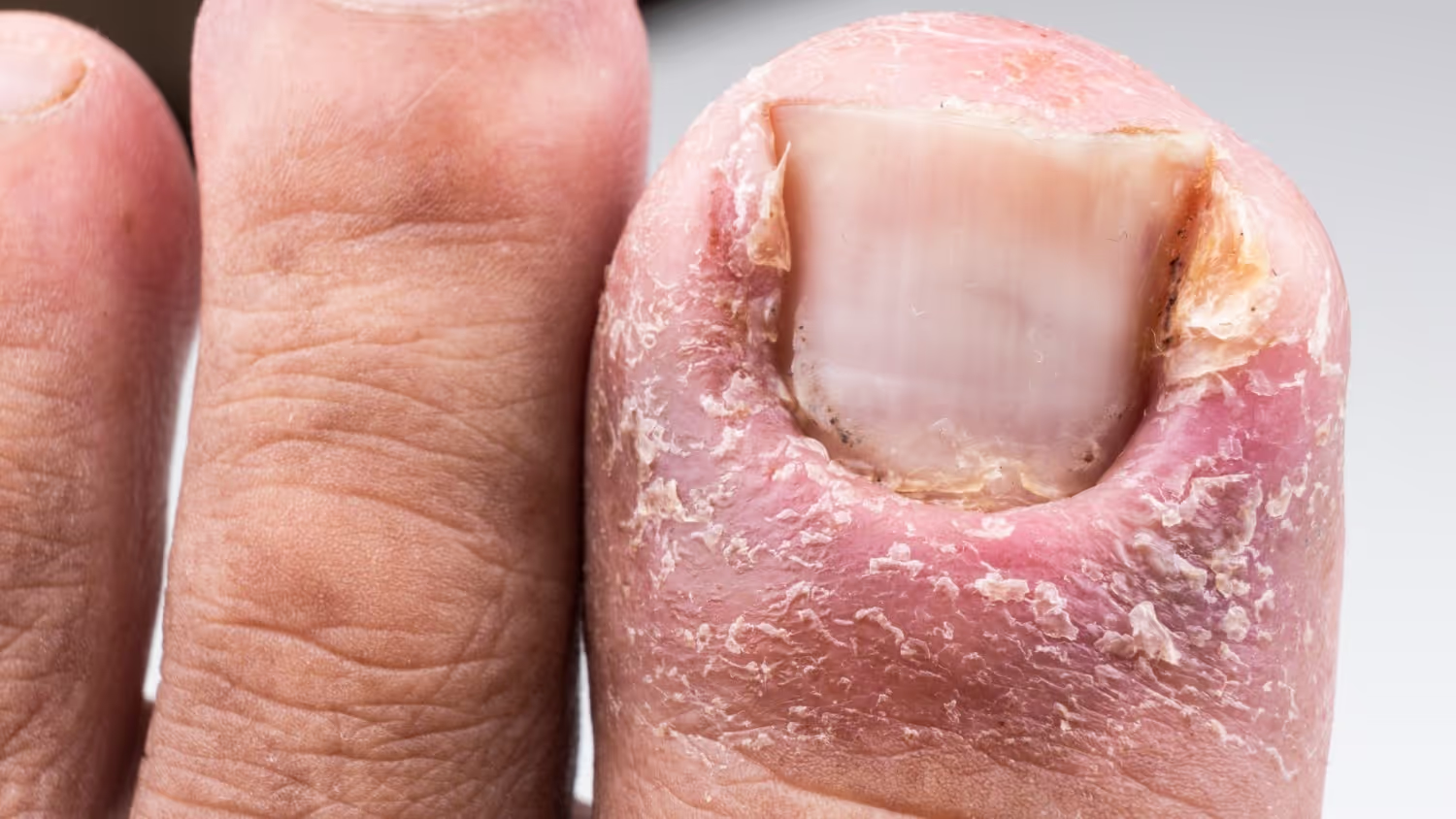
A fungal infection occurs when certain types of fungi grow uncontrollably on or inside the body, affecting the skin, nails, or mucous membranes. While many fungi naturally live harmlessly on our skin or in the environment, infections happen when these fungi multiply beyond normal levels, often due to warm, moist conditions or a weakened immune system.
Some fungi, like Candida, are part of our normal flora but can become problematic, while others, such as dermatophytes, are picked up from external sources and feed on keratin in skin, hair, and nails.
Areas where fungal infections are common:
- Skin folds: underarms, groin, and under the breasts.
- Feet: between the toes, soles, and toenails.
- Scalp: especially in children.
- Nails: fingernails and toenails.
- Mouth: inside the cheeks, on the tongue, or in the throat.
6 Types of Fungal Infections
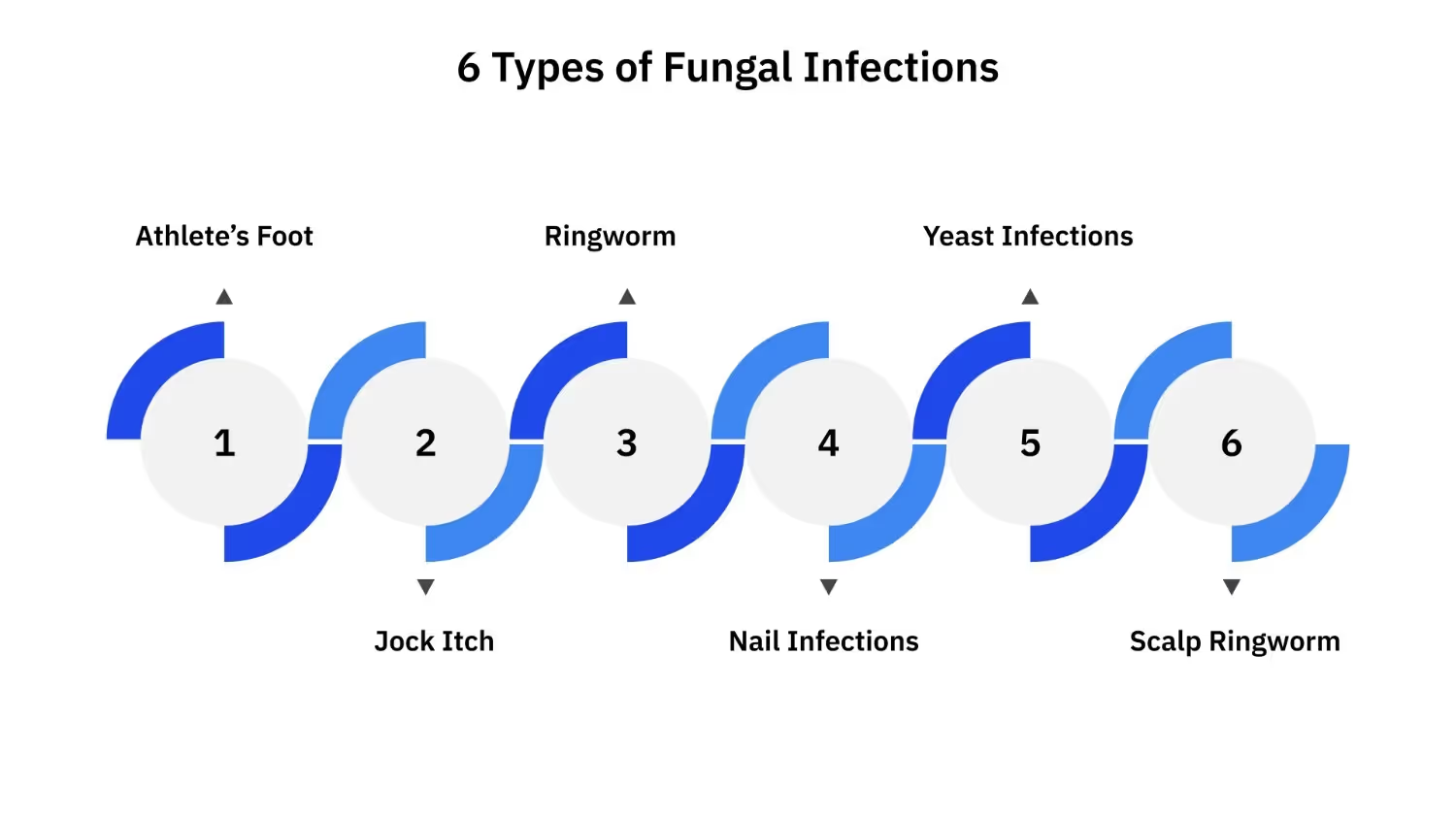
Fungal infections vary by fungus type and affected area, each with distinct symptoms, risks, and treatments. Early recognition improves treatment success and reduces complications.
Let’s look at some of the most common types of fungal infections.
Athlete’s Foot (Tinea Pedis)
Caused by dermatophyte fungi, athlete’s foot affects the feet, thriving in warm, moist environments such as inside closed shoes or communal showers. It spreads through direct contact or contaminated surfaces. Though not life-threatening, it can become chronic without proper care.
Symptoms
- Persistent itching or burning between the toes.
- Peeling, cracking, or scaling skin.
- Redness and inflammation in affected areas.
- Small blisters that may ooze or crust over.
- Dry, thickened skin on the soles in chronic cases.
Commonly affected areas
- Spaces between the toes.
- Soles of the feet.
- Toenails may become infected (tinea unguium/onychomycosis), typically as a complication rather than the primary infection site.
Jock Itch (Tinea Cruris)
Jock itch develops in the warm, moist folds of the groin, inner thighs, and buttocks. It is caused by dermatophyte fungi, the same group responsible for athlete’s foot and ringworm. The condition is more common in men, particularly those who sweat heavily, wear tight clothing, or participate in sports.
People who are overweight, have diabetes, or have a weakened immune system are also more susceptible. The infection spreads through skin-to-skin contact or contaminated towels, clothing, and sports gear.
Symptoms
- Red or reddish-brown rash with a well-defined, scaly border.
- Constant itching and burning in the groin area.
- Rash that may spread outward while the centre clears.
- Flaking or peeling skin at the edges of the rash.
Commonly affected areas
- Inner thighs.
- Groin folds.
- Buttocks crease.
Ringworm (Tinea Corporis)
Tinea Corporis is a highly contagious fungal infection that targets the skin on the body, excluding the scalp and beard area. Despite the name, it is not caused by worms but by dermatophyte fungi that thrive on keratin. It appears worldwide, but children and people in close-contact environments such as schools, sports teams, and shared housing are at higher risk.
Transmission occurs through direct skin contact, touching infected animals (especially cats and dogs), or using contaminated items like towels, bedding, or combs.
Symptoms
- Circular or ring-shaped rash with a clear centre and raised, scaly edge.
- Itching or mild discomfort in the affected area.
- Gradual expansion of the rash outward.
- Occasional mild redness and inflammation.
Commonly affected areas
- Arms
- Legs
- Trunk
- Face (excluding beard area)
Nail Infections (Onychomycosis)
Onychomycosis is a slow-growing fungal infection of fingernails or toenails, mostly caused by dermatophytes, but sometimes by yeast or moulds. It is more frequent in older adults due to slower nail growth and reduced circulation. Infection often starts after nail trauma or prolonged exposure to moist conditions like sweaty footwear.
Symptoms
- Thickened nails that may be brittle or crumbly.
- Yellow, brown, or white discolouration.
- Nails separating from the nail bed (onycholysis).
- Foul odour in advanced cases.
- Pain or discomfort when walking or using the affected fingers.
Commonly affected areas
- Big toenails.
- Fingernails of the dominant hand.
Yeast Infections (Cutaneous Candidiasis)
Yeast infection is often caused by the overgrowth of Candida yeast on the skin. While Candida normally lives harmlessly on the skin and mucous membranes, it can become pathogenic in warm, moist areas. This condition is most common in individuals with diabetes, those who are overweight, or people with weakened immune systems. Prolonged antibiotic use, pregnancy, and wearing tight, non-breathable clothing can also increase susceptibility.
Symptoms
- Red, raw-looking patches with well-defined edges.
- Itching and burning in affected areas.
- Small pustules or satellite lesions around the main rash.
- White, cottage cheese-like discharge in moist areas (e.g., skin folds, genital region).
- Increased discomfort in hot or humid conditions.
Commonly affected areas
- Genital area.
Scalp Ringworm (Tinea Capitis)
Tinea capitis is a contagious scalp fungal infection affecting the scalp and hair shafts, caused by dermatophyte fungi such as Trichophyton and Microsporum species. It primarily affects children aged 3 to 7, but can also occur in adults with weakened immunity. It spreads through contact with infected people, animals, or contaminated objects like combs and hats.
Symptoms
- Round, scaly patches of hair loss.
- Brittle hair that breaks easily at the scalp surface, leaving “black dots”.
- Itching and tenderness of the scalp.
- Swollen lymph nodes are present in severe cases.
- Painful, inflamed areas with pus (kerion) in advanced infections.
Commonly affected areas
- Crown of the head.
- Sides and back of the scalp.
If you notice one or more of these signs, consult a qualified dermatologist rather than waiting for them to disappear. Early intervention not only speeds recovery but also prevents the infection from spreading to healthy skin.
Causes and Risk Factors of Fungal Infections
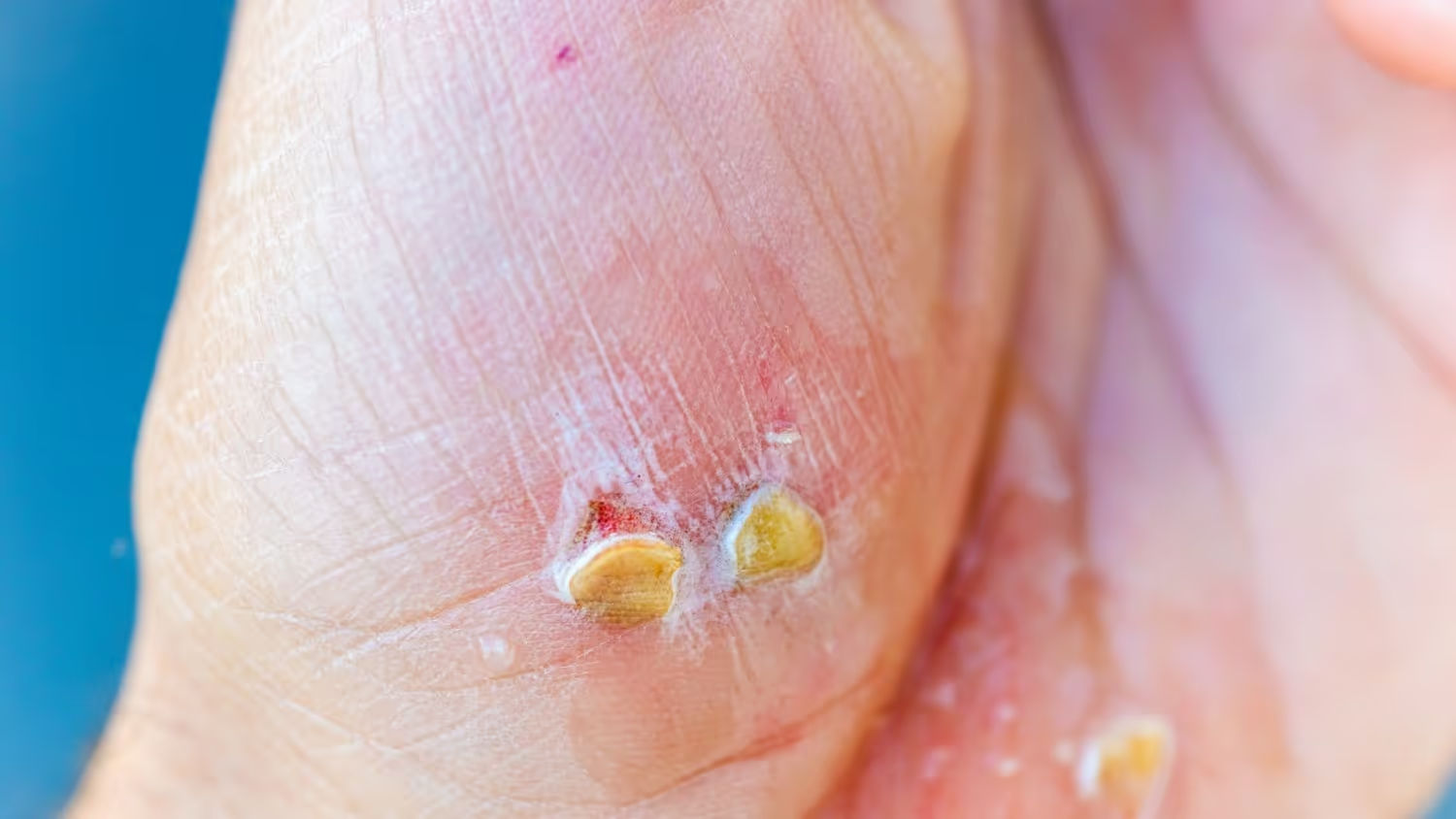
Understanding what causes fungal infections helps you take adequate preventive measures. Multiple factors can increase your susceptibility to these persistent conditions. Let's examine the main contributors to fungal infection development.
Medical Conditions Increasing Risk
Certain health conditions weaken your body's natural defences against fungi. Diabetes disrupts your immune system's ability to fight infections effectively. High blood sugar levels create an ideal environment for fungal growth.
Conditions that increase infection risk:
- Diabetes mellitus (poor blood sugar control).
- HIV/AIDS or other immune disorders.
- Cancer treatments that suppress immunity.
- Chronic kidney or liver disease.
- Autoimmune conditions like lupus or rheumatoid arthritis.
Lifestyle & Environment Factors
Your daily habits and environment significantly impact fungal infection risk. Hot, humid climates provide perfect breeding conditions for fungi. Overcrowded living conditions increase person-to-person transmission rates.
Environmental risk factors:
- Living in tropical or humid climates.
- Spending time in communal areas (gyms, pools, locker rooms).
- Working in environments with poor ventilation.
- Sharing living spaces with infected individuals.
- Keeping pets that may carry fungal spores.
Medication-Related Risks
Certain medications alter your body's natural balance of microorganisms. Antibiotics kill beneficial bacteria that usually compete with fungi. This creates opportunities for fungal overgrowth to occur.
Medications that increase risk:
- Broad-spectrum antibiotics are taken for bacterial infections.
- Corticosteroids (oral or topical) are used long-term.
- Chemotherapy drugs that suppress immune function.
- Birth control pills that alter hormone levels.
- Immunosuppressive drugs for organ transplants.
Always inform your dermatologist about all medications you're taking. They can adjust treatment plans to account for increased infection risk. Never stop prescribed medicines without consulting your doctor first.
Diagnosis of Fungal Infections

Getting the correct diagnosis is important to treat fungal infections properly. Fungal infections can resemble other skin problems, so a careful check-up is necessary to confirm the diagnosis.
What Happens During a Medical Check?
A healthcare provider will:
- Look closely at the spots or areas affected.
- Ask about how long the symptoms have been there and how they have changed.
- Review your medical history, including any illnesses or medicines you are taking.
- Ask if you have tried any treatments before and how they worked.
This helps doctors determine whether the condition is a fungal infection or something else, such as eczema or allergies.
Tests to Confirm Fungal Infection
If it is not clear just by looking, some simple tests may be done:
- Microscope Test (KOH Test): Your doctor will gently scrape some skin or nail and check it under a microscope. This test helps find fungal cells quickly by dissolving skin cells and revealing fungal elements like spores or hyphae. It is a rapid, cost-effective test with sensitivity between 70% and 85%.
- Fungal Culture: A sample of the infected skin or nail is sent to a lab, where they try to grow the fungus. This test takes 2 to 4 weeks but identifies exactly which fungus is causing the infection. This information helps choose the best antifungal medicine. The culture test is very accurate, with a sensitivity of around 90%, but requires specialised lab work.
- Skin Sample (Biopsy): Sometimes, a small piece of skin may be taken for closer examination under a microscope using special stains. This is useful in deep or complicated infections to confirm the fungus within the tissue.
- Special Light Test (Wood’s Lamp): Your doctor might use a special ultraviolet light that makes some fungi glow (e.g., Microsporum species show a blue-green colour). However, most common fungi, such as Trichophyton rubrum or Candida, do not fluoresce, so this test is only useful in specific cases.
If the infection is deep or affects organs inside the body (which is rare), other tests like blood tests, X-rays, or scans may be needed.
Accurate diagnosis helps your doctor provide the best care and eliminate the infection effectively.
Fungal Infection Treatment Options
Effective treatment of fungal infections depends on selecting the proper medication tailored to your specific condition. Approaches vary according to the infection’s type, severity, and location.
Below are the standard treatment methods used depending on the nature and severity of the infection.
Topical Antifungal Creams, Ointments, and Powders
For mild to moderate fungal infections, topical treatments work by targeting the fungi directly where the infection is. You’ll usually need to apply these medications consistently for 2 to 4 weeks to clear the infection entirely.
Common topical antifungal medications you might use include:
- Clotrimazole: Effective against the most common fungal types.
- Terbinafine: Especially good for athlete’s foot and ringworm.
- Miconazole: Works well for yeast infections and skin folds.
- Ketoconazole: Used for stubborn or recurring infections.
- Tolnaftate: Helps prevent infection from coming back.
Oral Antifungal Medications for Severe Cases
If your infection is severe, widespread, or affects nails or scalp, oral antifungal medications may be necessary. These treatments work from inside your body and often require monitoring for side effects.
You might need oral medication if:
- The infection covers large areas of your body.
- Nail infections don’t improve with topical treatment.
- You have scalp ringworm.
- Your immune system is weakened.
- You experience recurring infections despite treatment.
Common oral antifungal drugs include:
- Itraconazole: An alternative if terbinafine isn’t suitable.
- Griseofulvin: Occasionally used for scalp ringworm in children.
Treatment can last from 6 weeks to 12 months, depending on the infection type and severity.
Many people stop their medication once symptoms improve, but fungal spores can linger even when your skin looks better. Finishing your full course of treatment is essential for proper recovery.
When to Seek Medical Help for Fungal Infections?

Seeking medical care early helps prevent fungal infections from worsening and supports a quicker, safer recovery. Sure, warning signs indicate you should consult a healthcare professional promptly.
- Symptoms Lasting More Than Two Weeks
If over-the-counter treatments fail to improve symptoms within 1–2 weeks, it’s essential to consult a doctor. Persistent symptoms may require more potent prescription medications or a different diagnosis. Warning signs include no improvement, worsening symptoms, new or unusual signs, severe pain or swelling, and fever.
- Repeated Infections That Keep Coming Back
Frequent fungal infections often indicate underlying health issues or incomplete treatment. A specialist can identify causes like diabetes, immune problems, inconsistent therapy, contaminated items, skin barrier issues, or hormonal changes, and recommend preventive measures to break the cycle.
- Infections Spreading to Sensitive Areas
Fungal infections on delicate regions such as the face, scalp, genital area, or skin with breaks need specialised care. Untreated scalp infections risk permanent hair loss, while facial infections can worsen discomfort or spread. These areas require careful medical evaluation.
Recognising these signs and seeking timely care is the first step. Choosing the right provider and treatment plan is crucial. Velantis Dermatology offers expert, personalised care to guide you through effective fungal infection treatment.
How Velantis Dermatology Helps Treat Fungal Infections
Velantis Dermatology provides comprehensive fungal infection treatment using evidence-based medical protocols. Our systematic approach ensures accurate diagnosis and effective treatment for lasting results. Every patient receives individualised care from our qualified MD dermatologist.
Evidence-Based, Doctor-Led Care
MD Dermatologist at Velantis, Dr. Janani Sree CM brings extensive medical training to every consultation. All treatments follow established dermatological guidelines backed by scientific research. You receive the same quality of care you'd expect at any major medical institution.
Our medical approach includes:
- Systematic examination using proven diagnostic criteria.
- Treatment protocols are based on the latest medical research.
- Monitoring progress with objective clinical measurements.
- Adjustment of therapy based on individual response.
Accurate Diagnosis with Advanced Tools and Testing
Our dermatologist employs appropriate diagnostic methods to identify fungal infections accurately. These tests help differentiate fungal conditions from other skin issues with a similar appearance. Accurate diagnosis guides effective treatment choices, improving outcomes and reducing unnecessary delays caused by trial-and-error.
Individualised Treatment Plans to Prevent Recurrence
Every patient receives a customised treatment plan addressing their specific needs. We consider your medical history, lifestyle factors, and infection characteristics.
Personalised care includes:
- Medication selection is based on your specific fungal type.
- Dosage adjustments for your age, weight, and medical conditions.
- Treatment duration optimised for complete cure.
- Lifestyle modifications to reduce reinfection risk.
- Follow-up scheduling to monitor progress and prevent recurrence.
Ethical, Patient-First Approach
We prioritise your health and wellbeing over profit margins. We recommend only treatments that provide genuine medical benefit. No unnecessary procedures or expensive cosmetic add-ons are pushed during consultations.
Our ethical standards include:
- Transparent discussion of all treatment options and costs.
- Honest assessment of treatment expectations and timelines.
- Recommendation of the most cost-effective and appropriate therapy.
Prevention Strategies to Avoid Recurrence of Fungal Infections

Preventing fungal infections requires consistent attention to personal hygiene and environmental factors. Simple daily habits can significantly reduce your risk of developing new infections. These strategies also prevent recurrence after successful treatment completion.
Maintaining good hygiene and managing your environment consistently reduces the chance of new fungal infections and stops previous infections from returning.
Maintain Hygiene
Regular washing removes fungal spores, while thorough drying prevents their growth.
- Bathe or shower daily, using antifungal soap if advised.
- Dry carefully between toes, underarms, and skin folds.
- Change underwear and socks daily, more often if you sweat heavily.
- Always use clean towels and washcloths.
- Apply antifungal powder to areas prone to infection.
Choose Breathable Fabrics and Rotate Footwear
Breathable clothing and shoe rotation help keep moisture away from your skin.
- Wear cotton or moisture-wicking socks and loose, breathable underwear.
- Choose shoes with good ventilation and enough space for your toes.
- Rotate shoes regularly to allow them to dry thoroughly.
- Avoid tight clothing that traps sweat and heat.
- Replace worn-out socks and consider antifungal sprays for footwear.
Cleaning and Sanitising
Fungi can live on surfaces, so regular cleaning is essential to prevent reinfection.
- Wash towels, bedsheets, and pillowcases weekly in hot water.
- Disinfect shoes, socks, nail clippers, and bathroom surfaces often.
- Do not share personal items such as towels, razors, or nail tools.
- Replace items that cannot be adequately cleaned or sanitised.
Conclusion
Fungal infections can be persistent and challenging, but with the proper diagnosis, evidence-based fungal infection treatment, and consistent prevention strategies, you can achieve lasting relief and healthier skin.
At Velantis Dermatology, patient well-being is our top priority. We focus on personalised care, transparent communication, and medically proven therapies, never unnecessary treatments or costs.
If you’re ready to take control of your fungal infection with expert guidance, Book a Consultation with our MD Dermatologist, Dr. Janani Sree CM, today!
FAQs
Q1. Which test is best for fungal infection?
A1. The fungal culture test provides the most precise identification by growing the fungus in a lab. It guides targeted treatment, though it takes weeks. The KOH microscopy test is faster and commonly used for initial diagnosis, detecting fungal elements under a microscope.
Q2. Can you get a fungal infection on your neck?
A2. Yes, fungal infections can occur on the neck, especially in warm, moist areas or skin folds. These infections often arise from dermatophytes or yeast overgrowth and may cause redness, itching, and scaling in the affected neck region.
Q3. What is Candid B cream used for?
A3. Candid B cream combines an antifungal and an anti-inflammatory steroid. It treats fungal skin infections with inflammation and itching. Use it only under medical supervision to avoid steroid misuse, which can worsen fungal infections or cause skin thinning.
Q4. Where do fungal infections start?
A4. Fungal infections typically begin in warm, moist, and occluded areas of the body, such as skin folds, between toes, or under nails. These environments promote fungal growth, allowing the infection to establish before spreading if untreated.
Q5. What are the symptoms of too much yeast in your body?
A5. Excess yeast may cause redness, itching, soreness, and white discharge in skin folds or mucous membranes. Systemic overgrowth can lead to fatigue, digestive issues, and immune disturbances, though these require medical diagnosis and treatment.
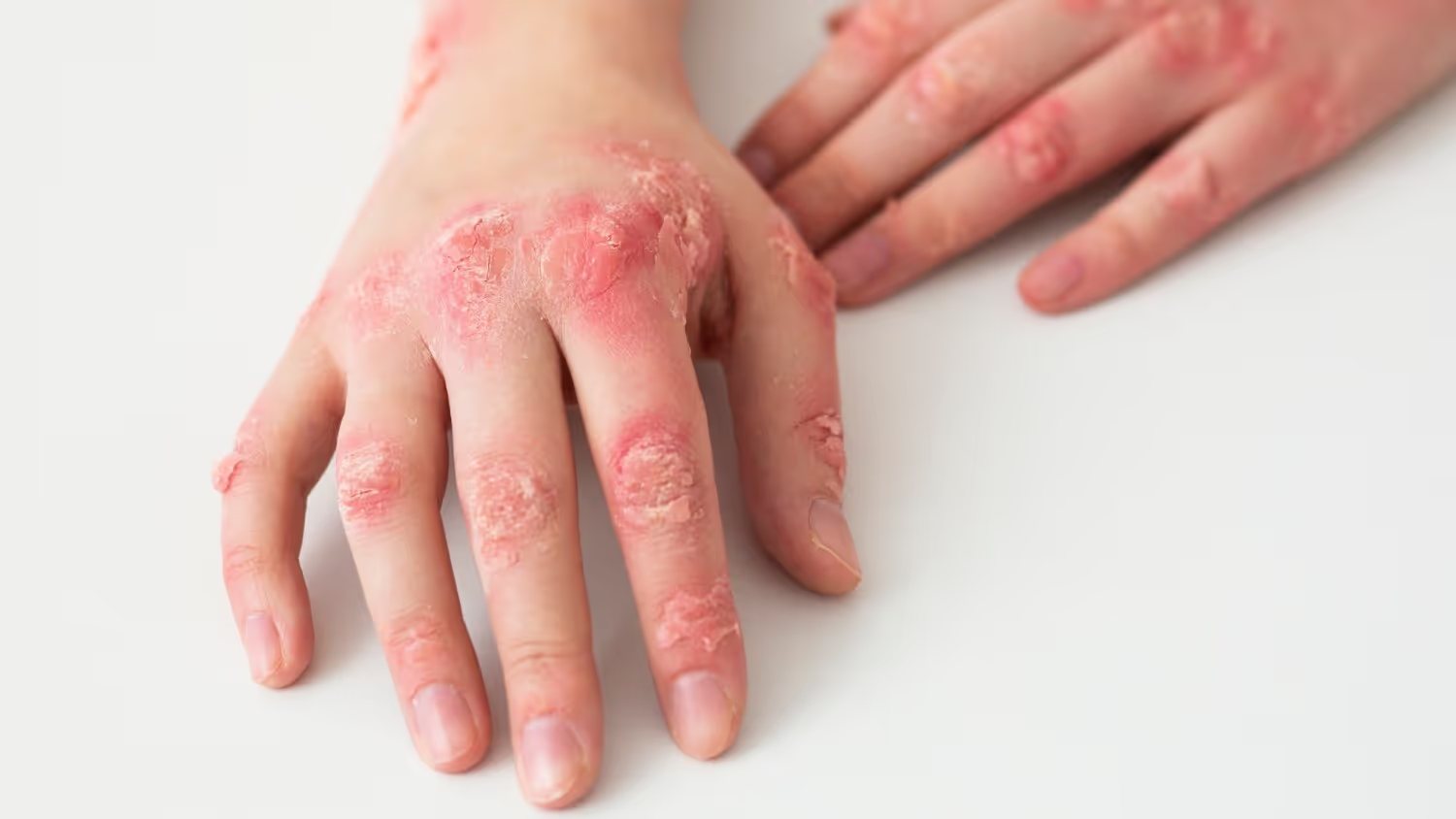

.png)
